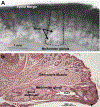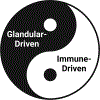The Yin and Yang of non-immune and immune responses in meibomian gland dysfunction
- PMID: 38224775
- PMCID: PMC11881750
- DOI: 10.1016/j.jtos.2024.01.004
The Yin and Yang of non-immune and immune responses in meibomian gland dysfunction
Abstract
Meibomian gland dysfunction (MGD) is a leading cause of dry eye disease and one of the most common ophthalmic conditions encountered in eye clinics worldwide. These holocrine glands are situated in the eyelid, where they produce specialized lipids, or meibum, needed to lubricate the eye surface and slow tear film evaporation - functions which are critical to preserving high-resolution vision. MGD results in tear instability, rapid tear evaporation, changes in local microflora, and dry eye disease, amongst other pathological entities. While studies identifying the mechanisms of MGD have generally focused on gland obstruction, we now know that age is a major risk factor for MGD that is associated with abnormal cell differentiation and renewal. It is also now appreciated that immune-inflammatory disorders, such as certain autoimmune diseases and atopy, may trigger MGD, as demonstrated through a T cell-driven neutrophil response. Here, we independently discuss the underlying roles of gland and immune related factors in MGD, as well as the integration of these two distinct mechanisms into a unified perspective that may aid future studies. From this unique standpoint, we propose a revised model in which glandular dysfunction and immunopathogenic pathways are not primary versus secondary contributors in MGD, but are fluid, interactive, and dynamic, which we likened to the Yin and Yang of MGD.
Copyright © 2024 Elsevier Inc. All rights reserved.
Conflict of interest statement
Disclosure of Conflicts of Interest
DRS is a consultant for Roche, Genentech, and Tarsus Pharmaceuticals, and has previously performed investigator-initiated research for Novartis. VLP is a consultant for BrightStar, BRIM Biotechnology, Kala Pharmaceuticals, Novartis, Quidel, and Thea, as well as a consultant and advisory board member for Dompe, consultant and equity holder for Kiora and Trefoil Therapeutics, and has received research support from Alcon. For all other authors, there are no disclosures to report.
Figures




Similar articles
-
Is Meibomian Gland Dysfunction One Disease? Heterogeneity Among Phenotypes.Cornea. 2024 Nov 1;43(11):1410-1417. doi: 10.1097/ICO.0000000000003542. Epub 2024 Apr 2. Cornea. 2024. PMID: 38563551
-
Models for Meibomian gland dysfunction: In vivo and in vitro.Ocul Surf. 2024 Apr;32:154-165. doi: 10.1016/j.jtos.2024.03.003. Epub 2024 Mar 13. Ocul Surf. 2024. PMID: 38490475 Review.
-
Efficacy of meibomian gland expression combined with Home-Based therapy in the management of dry eye Disease: A systematic review and Meta-Analysis.Cont Lens Anterior Eye. 2024 Apr;47(2):102107. doi: 10.1016/j.clae.2023.102107. Epub 2023 Dec 22. Cont Lens Anterior Eye. 2024. PMID: 38135593
-
Calcium-Dependent Regulation of Desmosomal Proteins in Human Meibomian Gland Epithelial Cells.Invest Ophthalmol Vis Sci. 2025 Jun 2;66(6):49. doi: 10.1167/iovs.66.6.49. Invest Ophthalmol Vis Sci. 2025. PMID: 40521979 Free PMC article.
-
Applied anatomy and morphology of Meibomian glands in the non-human primate.Sci Rep. 2025 Jul 1;15(1):20749. doi: 10.1038/s41598-025-05452-9. Sci Rep. 2025. PMID: 40596124 Free PMC article.
Cited by
-
Efficacy of indirect intense pulsed light irradiation on meibomian gland dysfunction: a randomized controlled study.Int J Ophthalmol. 2024 Nov 18;17(11):2014-2022. doi: 10.18240/ijo.2024.11.06. eCollection 2024. Int J Ophthalmol. 2024. PMID: 39559304 Free PMC article.
References
-
- McCulley JP, Sciallis GF. Meibomian keratoconjunctivitis. Am J Ophthalmol. 1977;84:788–93. - PubMed

